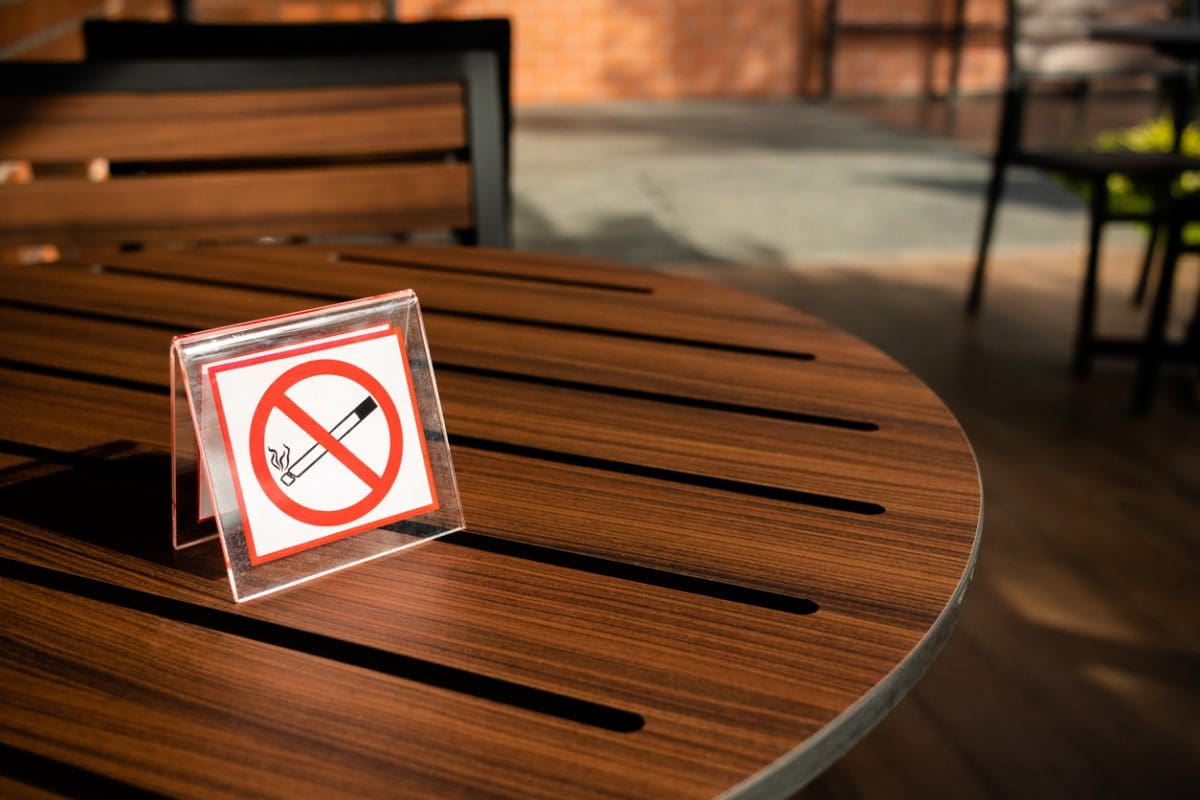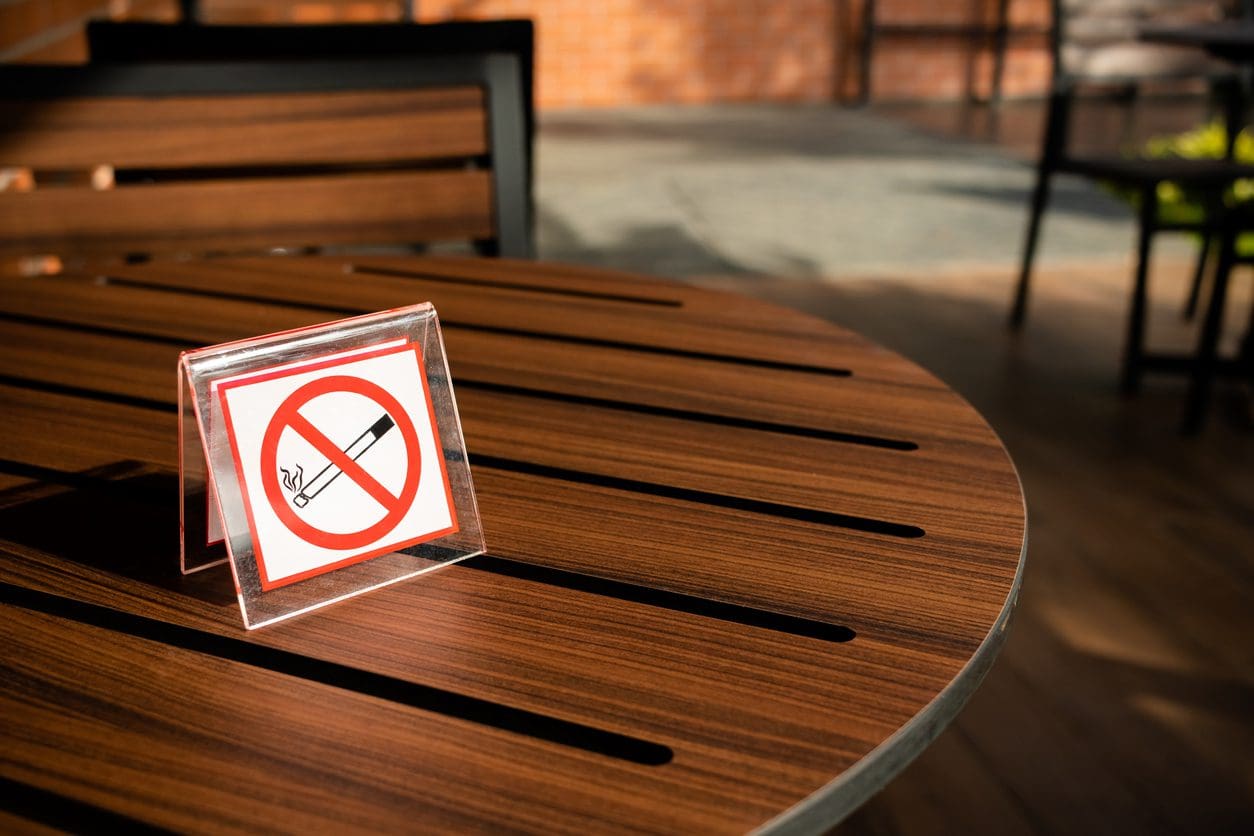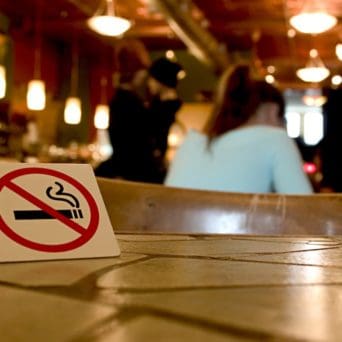This is a guest post by Americans for Nonsmokers’ Rights Foundation
We’ve known for years that there is no risk-free level of secondhand smoke exposure. It’s a leading cause of death and disease in the U.S., but millions of Americans are still not guaranteed clean, smoke-free air in multiunit housing, workplaces, and public spaces. Smoke-Free Indoor Air policies prioritize individual and community health by ensuring that businesses and other indoor spaces remain free from smoke and vapor from tobacco and cannabis, giving everyone the right to clean, safe air. Effective models for creating a smoke-free community exist, and places that have adopted them have seen economic and health benefits.
For over 39 years, Americans for Nonsmokers’ Rights Foundation has been the leading grassroots organization striving for smokefree protections, promoting prevention and education about smoking and secondhand smoke and exposing tobacco industry interference with public health policies. Together with our partners at CityHealth, we are available to provide specialized technical assistance when your city is ready to implement a lifesaving smokefree policy.
The Case for Smoke-Free Indoor Air
Sixteen years ago, the U.S. Surgeon General released a landmark report affirming the harmful effects of tobacco use and secondhand smoke exposure, which together kill nearly 500,000 Americans every year — including 41,000 deaths among nonsmoking adults and 400 deaths in infants. Among its numerous health impacts, exposure to secondhand smoke has been linked to heart disease and stroke, lung cancer, reproductive problems, sudden infant death syndrome, and asthma attacks in children.
The Centers for Disease Control and Prevention (CDC) states:
“There is no risk-free level of secondhand smoke, and even brief exposure can cause immediate harm. Research demonstrates that eliminating smoking in public places and workplaces improves worker and public health. There is a large body of research that documents the immediate reduction in hospital admissions for heart attacks shortly after a smokefree law goes into effect.”
Like tobacco smoke, marijuana smoke is a potent source of PM 2.5 fine particulate matter. It can impact cardiovascular function and contains thousands of chemicals and at least 33 known carcinogens. At least 468 municipalities and 23 states, commonwealths, and territories prohibit smoking and vaping of recreational and medical marijuana in non-hospitality workplaces, restaurants, bars, or gambling facilities. Legalized non-medical marijuana for adult use poses a significant threat to current smokefree protections and to expanding protections. Efforts are underway to establish public use cannabis lounges and cafes, which would lead to employee and patron exposure to this form of indoor air pollution.
Smokefree environments protect people from exposure to the toxins, gases, chemicals, and particulate matter that are released by burning tobacco and marijuana. By removing these harmful pollutants from the air that we breathe, smokefree policies create immediate and longer-term health benefits. With these clear benefits, it’s no surprise that momentum for local smoke-free policy action is growing, with more than 1,100 city governments from coast to coast having adopted smoke-free protections.
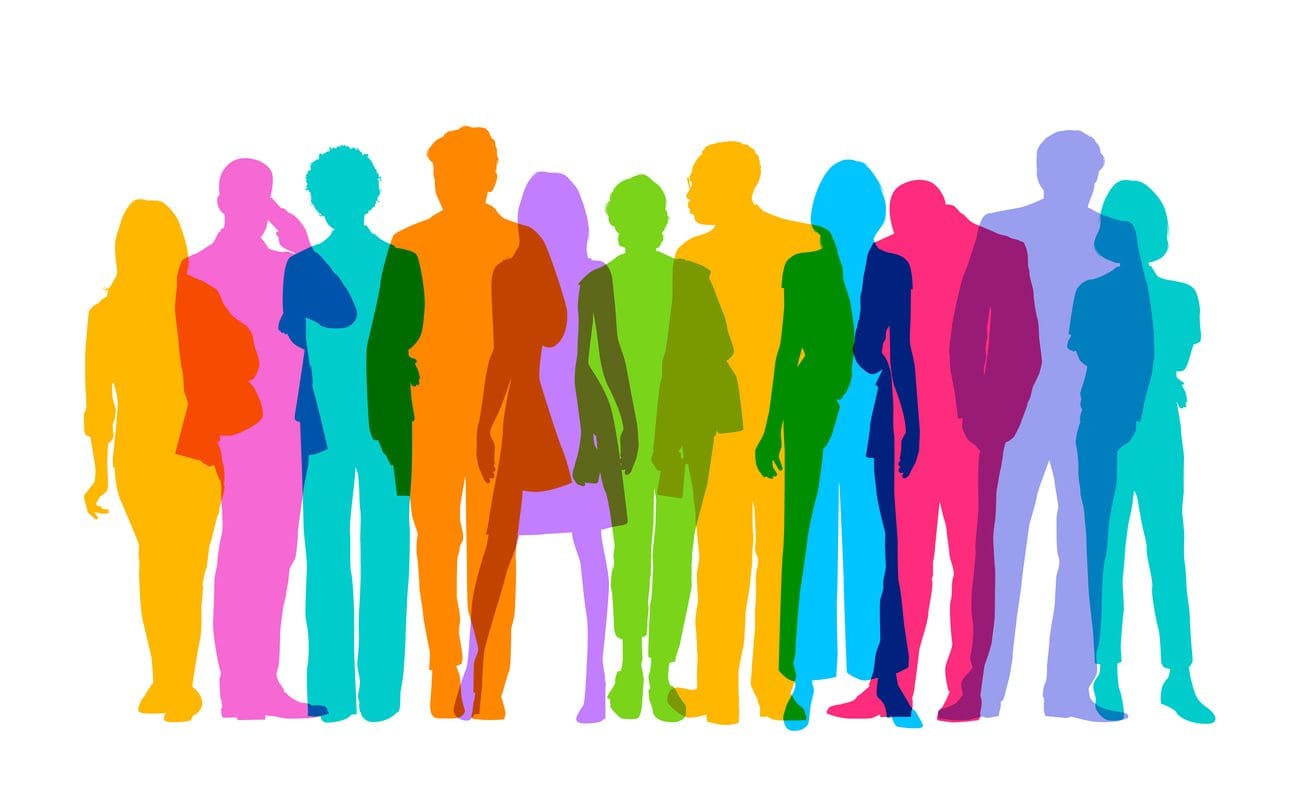
The Equitable Choice
“I was pregnant with my son… I had to be in a high roller room with six people smoking cigars and I had to just stand there and deal. And I did.” — Nicole, longtime Atlantic City casino dealer. Read more about Nicole’s story in her recent editorial.
Despite progress on smoke-free air, nearly 38% of Americans live in a place that is not fully protected by a 100% smoke-free law. These gaps in protection also widen preexisting health inequities in our country. People living in the same city can have starkly different exposures to secondhand smoke. Some may never be exposed while others experience secondhand smoke drifting into a child’s bedroom from the neighbor in the next-door apartment, waiting at a bus stop surrounded by smokers, or going to a smoke-filled workplace. Inequities linked to socioeconomic status, race, and sexual orientation are also linked to disparities in secondhand smoke exposure.
People of color and people who earn low incomes are disproportionately impacted by the lack of protective policies. Often, the businesses that are exempt from smoke-free regulations — like factories, restaurants, bars, and casinos — also employ members of these communities. By making white-collar workplaces smoke-free while allowing blue-collar workplaces to continue to expose people to dangerous air, our current policies are exacerbating disparities in health.
There is an opportunity for local leaders to safeguard residents’ health by implementing policies that close gaps in smoke-free indoor air regulations. These changes require an investment in health equity, but it is one that that benefits the entire community. In addition to lowering the consumption of tobacco in these areas and protecting non-smokers from the harmful effects of smoke, these policies also help to advance social, civic, and economic well-being. Smoke-free regulations allow all people to enjoy public spaces without fear of smoke exposure, which could improve community bonds. And according to a comprehensive review by the World Health Organization’s International Agency for Research on Cancer, smoke-free policies do not harm businesses — and in some cases, they may even boost revenues.
Everyone deserves the right to fill their lungs with clean, smoke-free air, no matter where they work, play, or live. Enacting smoke-free laws that apply to all places for all people is the right choice for any city and the people who call it home.
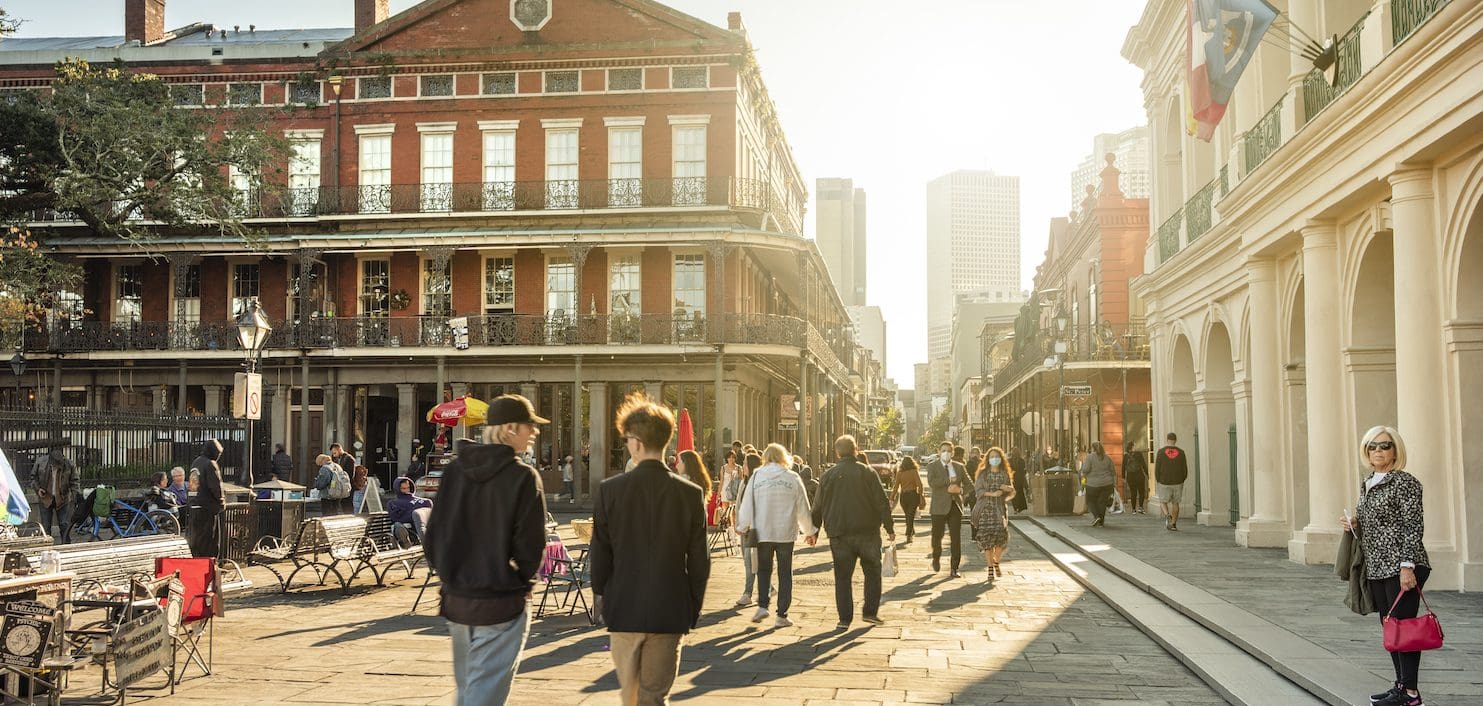
Smoke-Free in New Orleans
Under the leadership of then-Councilmember and current Mayor LaToya Cantrell, New Orleans passed the first local ordinance in the country to include 100% smoke-free air in casino gaming facilities as well as workplaces, restaurants, and bars in 2015. The law prohibits not only cigarette smoking, but also the use of electronic smoking devices in indoor workplaces and public places. The secondhand aerosol emitted by e-cigarettes is not water vapor. The aerosol is a mixture of many substances, including nicotine, ultra-fine particles, volatile organic compounds, and toxins known to cause cancer. Peer-reviewed, published scientific evidence demonstrates that secondhand aerosol is not harmless; it is a new source of indoor air pollution and is hazardous to nonsmokers.
The New Orleans City Council took action to protect the thousands of hospitality workers that were exposed to secondhand smoke and vapor, making the vibrant nightlife scene healthier for all workers, residents, and the millions of tourists that visit every year. As the years passed, secondhand marijuana smoke became an issue and the city again took swift action by adding marijuana to the definition of smoking to ensure the integrity of their popular and effective smokefree law.
Going for Gold: Strengthening Smoke-free Protections
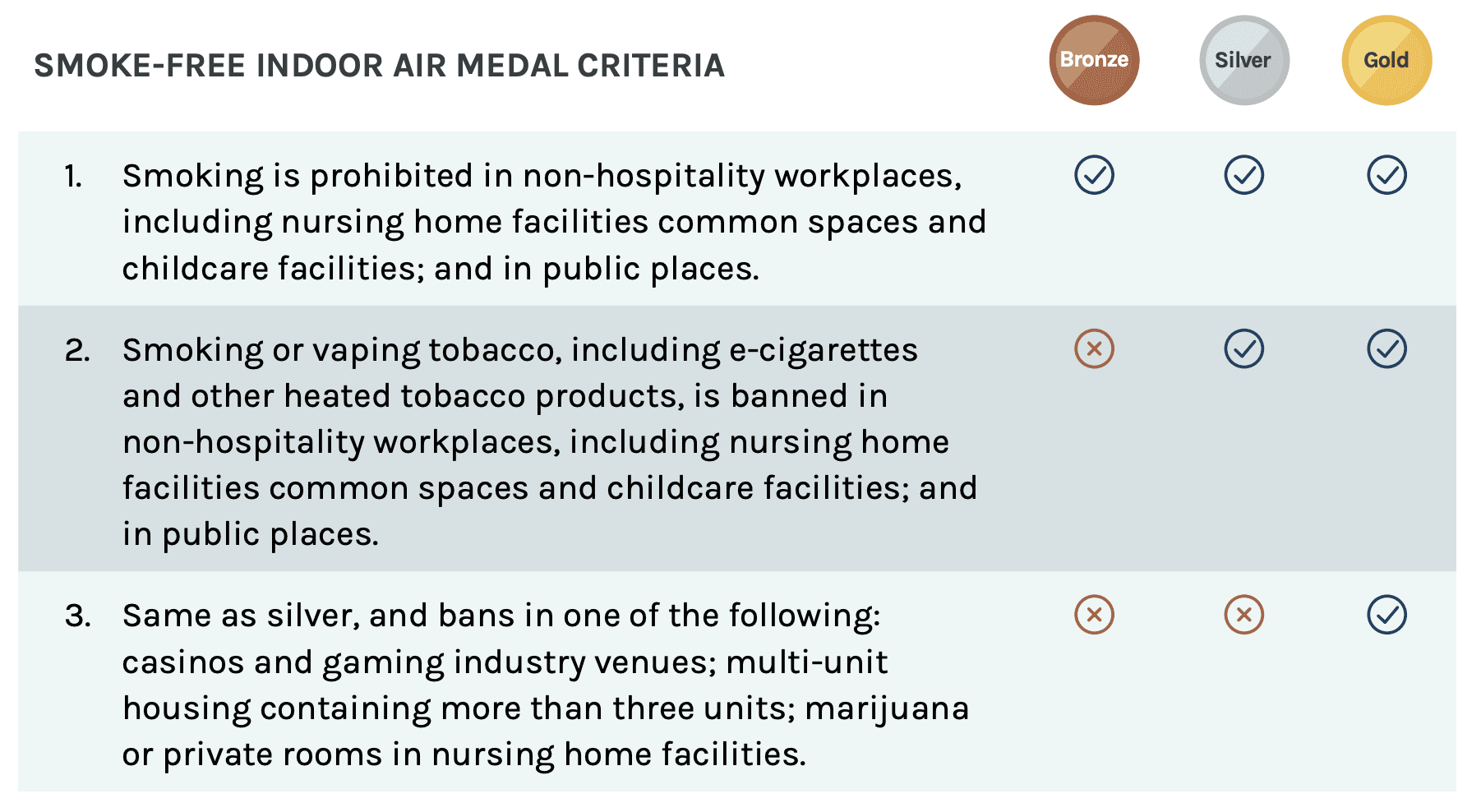
To earn a CityHealth bronze medal for Smoke-Free Indoor air, cities must prohibit smoking in non-hospitality workplaces, including nursing home facilities common spaces and childcare facilities; in restaurants and bars; and in public places. For CityHealth’s silver medal criteria, smoke-free protections must include prohibiting vaping e-cigarettes and other heated tobacco products. This maximizes health protections, eases enforcement of 100% smoke-free spaces, and ensures the act of smoking is not re-normalized in workplaces.
Cities should also safeguard protections by avoiding any new or closing existing loopholes for smoking related businesses like hookah or cigar bars. The cigar industry and their allies have lobbied local lawmakers touting the business opportunities for these venues, ignoring the research about health hazards and concerns for neighboring and adjoining businesses. These types of exemptions and loopholes overlook employee and resident health.
To earn a CityHealth gold medal, cities must (in addition to the criterion above) implement a smokefree ordinance that applies in at least one of four categories:
- Casinos and gaming industry venues
- Multi-unit housing containing more than three units
- Marijuana/cannabis
- Private rooms in nursing home facilities
It is critical to remove all forms of indoor air pollution caused by combustible tobacco and marijuana smoke and the secondhand aerosol or vapor from electronic smoking devices in order to provide acceptable indoor air quality for all workers and patrons. For support and additional resources to help your city implement a smoke-free law, please connect to us by contacting info@cityhealth.org.
Cynthia Hallett, MPH, is the President & CEO of Americans for Nonsmokers’ Rights (ANR) and the ANR Foundation
Onjewel Smith, MA, is the Southern States Strategist for Americans for Nonsmokers’ Rights (ANR) and the ANR Foundation
Traci Kennedy, MPA, is the Midwest States Strategist for Americans for Nonsmokers’ Rights (ANR) and the ANR Foundation

